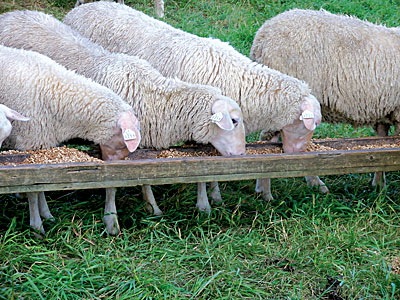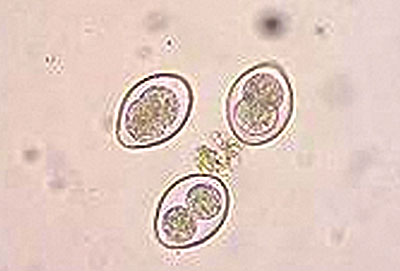 |
| Sheep eating Regano and grain at Ells farm in Union, Maine. |
By Diane Schivera, M.A.T.
Coccidia (Eimeria sp.), which are parasitic protozoa, and other internal parasite infestations are a major problem for many livestock farms, reducing growth rates and weight gains in young animals and thus reducing farm income.
When a coccidium leaves its host cell, it destroys the intestinal cell. One ingested oocyst (a cyst containing fertilized ova) can produce a million or more oocysts, which can destroy a million or more intestinal cells; and oocytes are passed in the feces.
Damaged epithelial lining cells leak blood or plasma into the lumen of the gut. If diarrhea, blood loss, dehydration, emaciation or bacterial septicemia does not kill the animal, some cells of the intestine will be replaced by scar tissue or by an increased turnover of epithelial cells, which are not efficient at absorbing nutrients from the intestine. These cells are also susceptible to bacterial invasion, which can be transmitted into the blood stream.
Animals that are infected when they are young become unthrifty, and their feed efficiency and performance are reduced for the rest of their lives, resulting in smaller breeding or slaughter stock.
 |
| Oocysts of Eimeria coccidia. |
Coccidia are normally present in most adult livestock, but the animals‘ health is rarely harmed. However, these adults do become a source of infection for young stock, as oocysts survive on wet ground. Stress, including housing or feed changes, shipping, overcrowding or weaning, or environmental stresses such as heat, cold or dampness, makes the animals more susceptible to infestation. Some stress is common when rearing animals, so coccidia or other parasites are also common.
As animals mature, their immune systems develop a natural resistance to coccidia. In healthy animals with highly functioning immune systems, this happens more quickly. Lambs that are exposed to infection early in life as a result of infection from the ewe and exposure to contaminated lambing ground develop a solid immunity if they are not stressed (although exposure to contaminated ground should not continue after they are weaned).
Good management, including frequently rotating lamb pastures and not allowing weaned animals to graze where adult animals have been for at least a year, helps control parasite infestation in young stock. Livestock producers with limited land, however, often cannot follow these practices. For farmers with small herds or flocks, animals can become precious to the point of becoming pets. The occurrence of coccidiosis in these management systems with such limited land is so predictable that coccidiostats are administered prophylactically.
Parasitism is also a major limiting factor for farmers who would like to become certified organic so that they can receive additional income from the sale of their livestock, because those farmers can no longer use synthetic coccidiostats once they become organic. These farmers with small, limiting systems would benefit from a coccidiostat that meets organic standards.
The continued prophylactic use of parasiticides has resulted in resistance of parasites to many common drugs. Thus, I applied for and received a USDA Sustainable Agriculture Research and Education grant to study Regano, an alternative, prophylactic treatment for coccidia that could be practical on small livestock operations with limited acreage and/or with animals of special value. (Parasites are not expected to become resistant to Regano because of its mode of action.) Along with four farmers, I also monitored levels of the nematode Haemonchus contortus and of tapeworms.
A Possible Solution
Regano is an essential oil distilled from select Greek strains of oregano (Origanum vulgare var. hirtum) that have antibacterial activity related to their phenolic content. The oil changes the permeability of the bacterial cell membrane to cations, such as H+ and K+. The oil works by the same mechanism as ionophores, such as the widely used coccidiostats monensin and salinomycin sodium. Regano is a natural product combined only with calcium carbonate and diatomaceous earth.
In initial studies in Italy on adult meat goats and beef cows, Regano reduced the coccidia load in test animals. (See references.)
I tested Regano on four Maine farms: a Boer goat farm (Charlie and Gail Vincent’s Sunnyside Farm in Warren); a cashmere goat farm (Yvonne Taylor’s Black Locust Farm in Washington); and two sheep farms – one with milking sheep (Ell’s Farm in Union, owned by Perry Ells) and one with Merino crosses for wool (Nan Kennedy’s Meadowcroft Farm in Washington). Both sheep farms also raised animals for meat. Each farm had a base level of coccidia and Haemonchus contortus. Ells Farm and Black Locust Farm had visually observable tapeworms.
I tested young stock on each farm, since young animals are most seriously affected.
Methods
We gave Regano to each animal after we took the first baseline fecal sample.
Eimeria behaves slightly differently in each livestock species, so we designed this project to account for that difference. We sampled goats’ feces on days 0, 20 and 64, and sheep on days 0, 25 and 64. The 64-day fecal sample accounted for a pre-patent period (the time between infection and production of larvae or oocysts) of three weeks and gave an indication of the effectiveness of Regano on any parasite that may have been ingested on pasture.
The project was managed similarly at all four farms, although the number of animals involved varied. The two sheep flocks each had 28 animals in the study; the goat herds had 15 and 11.
At approximately four weeks of age, each young animal had an initial fecal sample taken by digital, rectal collection (a difficult task with small goats and lambs). I observed the body condition of the animals at each collection date, and the farmers monitored animals’ continually during the study to ensure that the animals were not losing condition as a result of the treatment. Ell’s sheep flock was also weighed periodically, because the animals were involved in another study on feeding brewery grains.
The lambs at the second farm were FAMACHA scored at the last collection.
The test groups were given Regano daily in their normal ration at a rate of 2 g per 100 pounds of body weight. A control group was kept on a site with similar conditions to sites for the test groups, including the population of oocysts.
The Diagnostic Laboratory at the University of Maine in Orono analyzed the fecal samples, running quantitative and qualitative tests.
Kathy Murray, an entomologist with the Maine Department of Agriculture, analyzed the data.
Results
Despite the small sample size and animal variability, we got useful results.
The numbers of coccidia, Trichostrongyles (a group of nematodes) and tapeworms were compared before and after treatment for each animal. The reduction in numbers of each of these three parasites after treatment was calculated for each animal, and data were analyzed to determine the effects of treatment, herd and species (goats and sheep).
Coccidia numbers dropped for both treated and untreated animals, but the mean reduction in counts was 43 percent greater among treated than untreated animals. This effect of treatment was significant at the 7 percent level (p=0.07; i.e., the probability that the effects were due to chance rather than treatment was 7 percent).
Also, goats receiving Regano had 10 times fewer Haemonchus Contortus (Trichostrongyles) than untreated animals. This difference was significant at the p =0.029 level. There was no similar effect for sheep in this study.
We saw no effect of Regano on tapeworms in either sheep or goats.
The reliability of fecal sampling for oocyst or egg production can vary. Samples were taken at Ells Farm of the same animals, two weeks apart, to establish a baseline. Many of the first samples were too small for an accurate quantitative measurement, so we had to sample again. Numbers differed greatly between the first and second samples, even with no intervention. Egg production by the adult parasite varies over time and affects the reliability of testing somewhat.
Perry Ells was encouraged by results of the study. She measured a good rate of gain on her test animals compared with control animals. Charles Vincent was also positive.
Nan Kennedy and Yvonne Taylor did not observe so much success with their test animals. Factors specific to their farms may have affected their results.
Taylor’s cashmere kids were reluctant to consume the product, which did not mix well with the grain initially. Even moistening the mixture did not make it more enticing – although one funny kid in the control group kept trying to jump the gate between the groups. He was wild about Regano.
Due to scheduling difficulties, Kennedy’s lambs did not receive Regano until almost a month after baseline fecal testing, so the lambs were not protected from parasites at a crucial stage in their lives.
Economics
These are the cost comparisons for a 50-pound animal:
Regano 500 in a 10-pound jug costs $131.42 (retail) plus shipping. A dose of 2 g per day costs 5 cents, or $3 for the recommended two-month-long treatment (two cycles of the parasites).
Corid, a synthetic drug, costs $1.50 for the recommended 5-day treatment.
Ivermectin, a synthetic chemical sheep drench, costs 43 cents per dose. One treatment may be enough, but some farmers do two to six per year.
Thus, the costs for any of these treatments are comparable, especially considering the higher prices that organic livestock owners would get for their products.
Farmer Adoption
After the study, Ells wormed all the animals in the control group to improve their health. The group treated with Regano was growing well and did not need to be treated. She also observed fewer tapeworm segments in treated animals. Charles Vincent also believed that his animals gained well and were healthy. Both plan to use Regano this year.
Since Regano helped control coccidia, as well as Trichostrongyles in goats, it will likely be used more widely in sheep and goats.
Control of the Haemonchus contortus nematode in goats, the most exciting result of the study, deserves additional experimentation with adult sheep and goats. One of the deadliest parasites to all small ruminants, and the parasite showing the most resistance to many types of conventional wormers, this blood-sucker can quickly cause death from anemia. It would be useful to do an expanded study with adult sheep and goats to see if Regano controls this parasite. A natural control for Haemonchus would benefit conventional and organic farmers alike.
Resources and References
Efficiency of Oregano Essential Oil in Coccidiosis Control of Chronically Infected Goats, by Baricco G., Rambozzi L., Birolo M., Menzano A., Rossi L., Veterinarian practitioner, Dipartimento di Produzioni Animali, Epidemilogia ed Ecologia, University of Torino, Italy; Proc. IX° ESVCN Congress Turin, Italy, Sept. 2005.
Observations on a Test of Year-Old Calves with Regano® Carried Out from the Lombardic Consortium Veneto with the Supervision of the University of Milan, Italy. Adapted from a report by Giuseppe Baricco, March 30, 2006.
(Both reports above are available from Diane Schivera.)
Regano is available from Ralco Nutrition Inc., 1600 Hahn Rd., Marshall, MN 56258; 800-533-5306; Ken Danielowski Phone: 717-866-9513; www.ralconutrition.com.
About the author: Diane Schivera is MOFGA’s organic livestock specialist. You can contact her with your questions at 568-4142 or [email protected].
